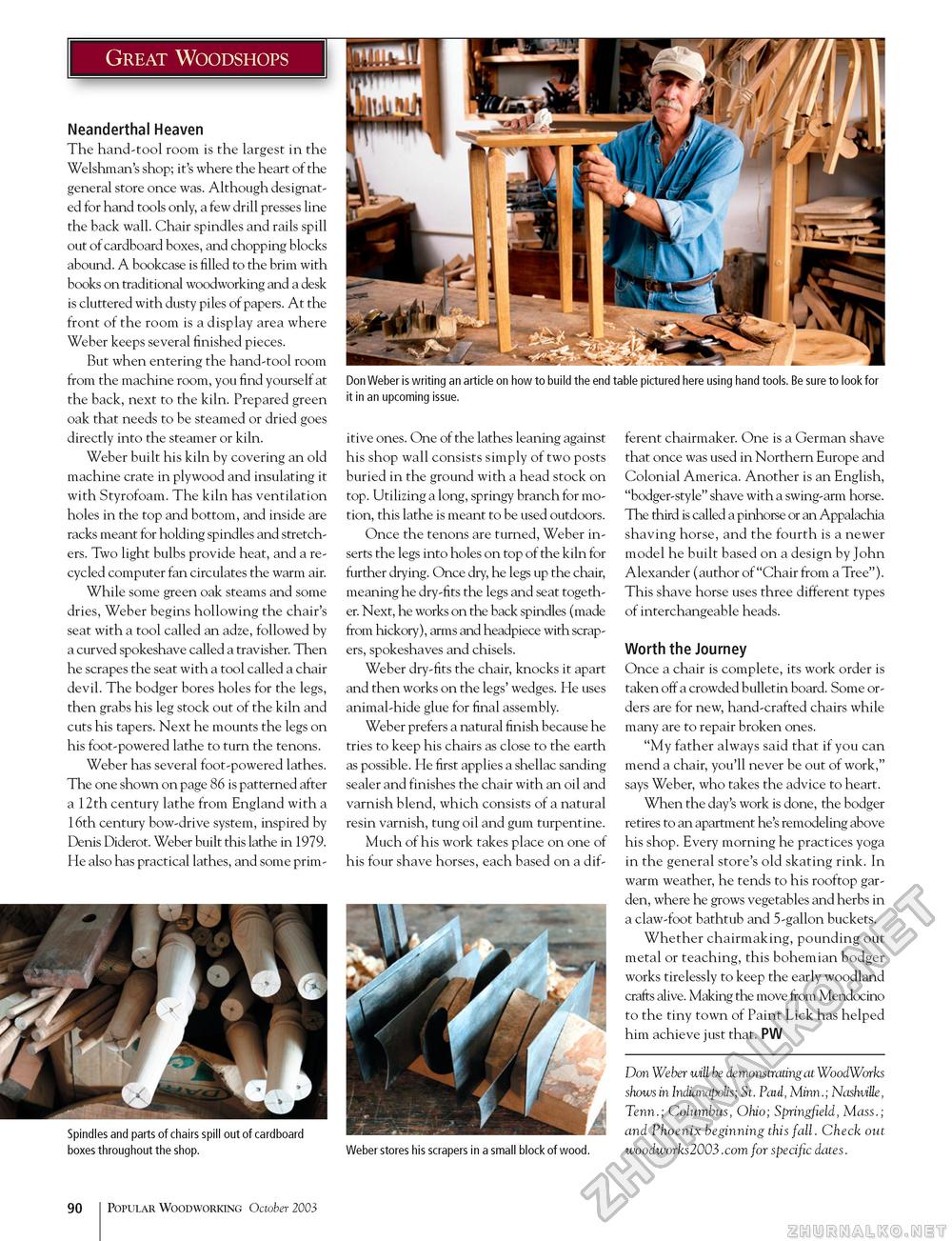Popular Woodworking 2003-10 № 136, страница 90
Neanderthal Heaven The hand-tool room is the largest in the Welshman's shop; it's where the heart of the general store once was. Although designated for hand tools only, a few drill presses line the back wall. Chair spindles and rails spill out of cardboard boxes, and chopping blocks abound. A bookcase is filled to the brim with books on traditional woodworking and a desk is cluttered with dusty piles of papers. At the front of the room is a display area where Weber keeps several finished pieces. But when entering the hand-tool room from the machine room, you find yourself at the back, next to the kiln. Prepared green oak that needs to be steamed or dried goes directly into the steamer or kiln. Weber built his kiln by covering an old machine crate in plywood and insulating it with Styrofoam. The kiln has ventilation holes in the top and bottom, and inside are racks meant for holding spindles and stretchers. Two light bulbs provide heat, and a recycled computer fan circulates the warm air. While some green oak steams and some dries, Weber begins hollowing the chair's seat with a tool called an adze, followed by a curved spokeshave called a travisher. Then he scrapes the seat with a tool called a chair devil. The bodger bores holes for the legs, then grabs his leg stock out of the kiln and cuts his tapers. Next he mounts the legs on his foot-powered lathe to turn the tenons. Weber has several foot-powered lathes. The one shown on page 86 is patterned after a 12 th century lathe from England with a 16th century bow-drive system, inspired by Denis Diderot. Weber built this lathe in 1979. He also has practical lathes, and some prim Don Weber is writing an article on how to build the end table pictured here using hand tools. Be sure to look for it in an upcoming issue. itive ones. One of the lathes leaning against his shop wall consists simply of two posts buried in the ground with a head stock on top. Utilizing a long, springy branch for motion, this lathe is meant to be used outdoors. Once the tenons are turned, Weber inserts the legs into holes on top of the kiln for further drying. Once dry, he legs up the chair, meaning he dry-fits the legs and seat together. Next, he works on the back spindles (made from hickory), arms and headpiece with scrapers, spokeshaves and chisels. Weber dry-fits the chair, knocks it apart and then works on the legs' wedges. He uses animal-hide glue for final assembly. Weber prefers a natural finish because he tries to keep his chairs as close to the earth as possible. He first applies a shellac sanding sealer and finishes the chair with an oil and varnish blend, which consists of a natural resin varnish, tung oil and gum turpentine. Much of his work takes place on one of his four shave horses, each based on a dif Spindles and parts of chairs spill out of cardboard boxes throughout the shop. Weber stores his scrapers in a small block of wood. ferent chairmaker. One is a German shave that once was used in Northern Europe and Colonial America. Another is an English, "bodger-style" shave with a swing-arm horse. The third is called a pinhorse or an Appalachia shaving horse, and the fourth is a newer model he built based on a design by John Alexander (author of "Chair from a Tree"). This shave horse uses three different types of interchangeable heads. Worth the Journey Once a chair is complete, its work order is taken off a crowded bulletin board. Some orders are for new, hand-crafted chairs while many are to repair broken ones. "My father always said that if you can mend a chair, you'll never be out of work," says Weber, who takes the advice to heart. When the day's work is done, the bodger retires to an apartment he's remodeling above his shop. Every morning he practices yoga in the general store's old skating rink. In warm weather, he tends to his rooftop garden, where he grows vegetables and herbs in a claw-foot bathtub and 5-gallon buckets. Whether chairmaking, pounding out metal or teaching, this bohemian bodger works tirelessly to keep the early woodland crafts alive. Making the move from Mendocino to the tiny town of Paint Lick has helped him achieve just that. PW Don Weber will be demonstrating at WoodWorks shows in Indianapolis; St. Paul, Minn.; Nashville, Tenn.; Columbus, Ohio; Springfield, Mass.; and Phoenix beginning this fall. Check out woodworks2003.com for specific dates. 90 Popular Woodworking October 2003 |








